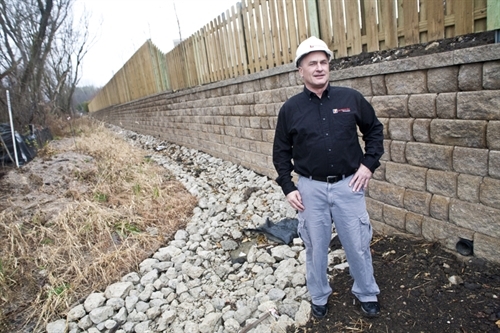
What Our Water's Worth is a campaign led by the Metropolitan Planning Council and Openlands to raise awareness about the value of water in northeastern Illinois and northwestern Indiana.
Green building ‘an easy sell’ that’s gaining ground

George K. Tuhowski III is on a mission to help people save water, energy and money by building green.
Photos by Emily Cikanek
By Tina Seaman
In a region where water is relatively inexpensive, making the case to install water-efficient systems and fixtures in green buildings could prove challenging. But, George K. Tuhowski III isn’t worried. “To me, it’s an easy sell when you explain to people what their water is worth,” he says.
Tuhowski is not only a leading practitioner of green building in metropolitan Chicago—he is also a dedicated water steward. His personal philosophy is reflected through his job as general superintendent and director of sustainability at the Leopardo Companies and his recent role serving as the 2010 chair of the Illinois Chapter of the U.S. Green Building Council (USGBC).
Yet his interest in green building stems from a much earlier age. George first started working in Chicago construction as a sophomore in high school, and he was shocked by how much waste occurs on job sites. Growing up in a family of eight children on Chicago’s South Side, George had been taught to be resourceful. As he puts it, “We weren’t being thrifty, we were just being smart.” So he began to salvage construction waste and brought scrap materials to recycling facilities.
But, George was also concerned about water waste. Fortunately, since he first started in the industry, building design and construction have come a long way toward sustainability and affordability. And he credits the USGBC for helping blaze the trail into a frontier that is much greener (and bluer, by saving water). In 2000, USGBC, which has 79 chapters throughout the country, including in Illinois and Indiana, laid the groundwork for the green building movement when it issued the first version of LEED criteria (Leadership in Energy and Environmental Design), creating a common definition and standard for green building.
LEED uses a weighted credit and point system that includes water-efficiency as one of its five environmental performance categories. Buildings that incorporate water-efficient landscaping, 20 percent or more indoor water use reduction, and innovative wastewater technologies can earn credits and points—which ultimately translate into significant water and cost savings for clients.
While building green can cost more upfront—usually an average of one to 15 percent, depending on the level of LEED certification (Certified, Silver, Gold, and Platinum) as well as site and building characteristics—according to George, clients are more willing to spend the initial premium once they realize the long-term return on investment through operation and maintenance cost savings.
Read on to find out how George, his clients, and other green building vanguards across the region are going blue—and pocketing green—in this month's edition of What Our Water's Worth.
Conservation tips
Save up to $300 through a federal tax credit. Water heating can account for 14 to 25 percent of the energy consumed in your home. By installing a more efficient water heater, you can receive a tax credit and reduce your carbon footprint.
Save an extra $135 each year on your utility bills. By replacing older clothes washers with an ENERGY STAR model, you will use about 37 percent less energy and 50 percent less water with each load, reducing your bills. Bonus: Many new washers have greater capacity, which means fewer total loads (and more free time!).
Save a further $170 by installing WaterSense fixtures. Simple home repair projects like installing a $7 aerator or $20 showerhead can lead to real savings over time.
July 2011
www.chicagolandh2o.org
Upcoming events
| Aug 18 | A Conversation with Charles Fishman, Author of The Big Thirst 11:30 AM–1:30 PM |
|---|---|
| Sep 26–28 | Solutions for Sustainable Communities Conference 8:00 AM–6:00 PM |
What Our Water's Worth is a campaign led by the Metropolitan Planning Council and Openlands to raise awareness about the value of water in northeastern Illinois and northwestern Indiana. From Lake Michigan to the Fox River, how we use our water resources—including what we conserve, how much we waste, and what we choose to invest in water quality—is up to each of us. This is our water—and it's worth more than we know.
WOWW factors
The amount of water a large tree can intercept in a large storm, helping recharge water supplies and reduce runoff.
$170,100
1.05 billion gallons a year
The amount of water diverted back into the ground, thanks to the City of Aurora’s Rooftops to Rivers program, which installed green infrastructure on a citywide scale.
What Our Water's Worth is a monthly e-newsletter. Tell us what you think. Email info@chicagolandh2o.org with feedback in the subject.
To subscribe, visit our website at chicagolandh2o.org.

|
Metropolitan Planning Council
140 S Dearborn St | Suite 1400 | Chicago, IL 60603 Phone (312) 922-5616 phone | Fax (312) 922-5619 |
Openlands
25 E. Washington St. | Suite 1650 | Chicago, IL 60602 Phone: 312-863-6250 | Fax 312-427-6251 |
Copyright © 2026. All rights reserved. | info@chicagolandh2o.org
To stop receiving this newsletter visit metroplanning.org/unsubscribe.html?EmailMsgId=132&email=
